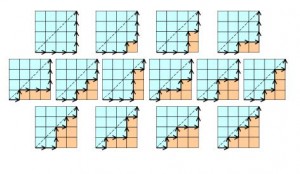The Department of Mathematics & Statistics would like to welcome:
Matt Willis, Connecticut College, on Tuesday, February 9, at 12:30 am in SCP 229
Title: The Combinatorics of Counting Catalan Numbers
Abstract: In short, Combinatorics is the mathematics of counting. Since most mathematicians are already pretty good at than, combinatorialists focus on counting objects that are of interest in other areas. For example, how many permutations are in the Symmetric group Sn? How many possible outcomes does the Powerball lottery drawing have? At the undergraduate level, combinatorics is often viewed as a “fun” subject that uses critical thinking to solve word problems. While that is certainly true, it is also a powerful subject that can use intense mathematics to answer difficult research questions. In this talk we will focus on a few specific counting problems. Some will be geometric or algebraic in nature using only polygons or graphs. For example, the picture below shows all paths in R2 made up of length 1 line segments from the origin to (4,4) that do not go above the line y = x; there are 14 such paths. (Those conditions seem quite random, we’ll discuss their relevance during the talk.) Other examples will be purely combinatorial involving objects such as “Young diagrams” and “semistandard Young tableaux.” Along the way we will encounter one of the most well-known counts in this subject: the Catalan numbers. No need to study, all of these terms will be introduced from scratch. If time allows, we will also discuss how some of these counts relate to some recent researching this field.
Bio: Matt Willis is a pure mathematician who specializes in Algebraic Combinatorics. Specifically, he is interested in the combinatorics of Young tableaux and often their interaction with symmetric functions or polynomials. He graduated from TCNJ in 2006 and owes much of his success to the school’s math faculty. He attended graduate school at the University of North Carolina at Chapel Hill, earning a Masters in 2009 and a PhD in 2012. Since then he spent one year teaching at Hampden-Sydney College in Virginia, and is now currently in his third year teaching at Connecticut College.

